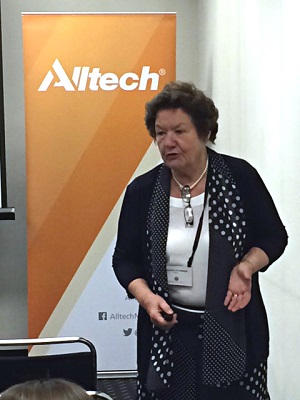Mycotoxins predicted to become more prevalent due to climate changes, will have greater impact on rumen function
Published: October 2, 2015
Source : Alltech Mycotoxins
Mycotoxins, often one of the most neglected considerations in ruminant diets, should be a major animal health and welfare concern in modern animal husbandry, according to one leading researcher and veterinarian.
“Under the conditions of modern agricultural practice, mycotoxin contamination of feed materials cannot entirely be avoided,” said Dr. Johanna Fink-Gremmels, Utrecht University. “It is predicted that at the current level, the prevalence of mycotoxins will increase due to changes in the climate.”
More than 50 dairy producers and industry members attended the Alltech Mycotoxin Roadshow this week at World Dairy Expo in Madison, Wisconsin, where Fink-Gremmels presented a snapshot of the global mycotoxin problem as well as the role mycotoxins play in the health and performance of dairy cows during her presentation, “Impacts of Mycotoxins on Dairy Cows.”
According to Fink-Gremmels, mycotoxins are currently the most prominent feed contaminants worldwide, attributing to a 25 percent decrease in genetic potential in dairy cows and an economic loss to the United States alone estimated at more than $1 billion annually. Natural toxins produced by diverse fungal species, mycotoxins are increasing in diversity through both pre- and post-harvest contamination.
Total mixed rations can often contain more than one fungal species, contributing to a complex mixture of mycotoxins and unresolved health issues in the herd. According to Fink-Gremmels, the greatest problem for dairy cows is multiple mycotoxin contamination in silage. Dairy producers need to observe cow signals such as reduced feed intake, reproductive disorders, laminitis, mastitis, impaired liver function, poor response to vaccination programs, and increased susceptibility to bacterial and viral diseases, which can all be attributed to ingesting mycotoxin contaminated feed.
“The rumen determines health and productivity of the cow. When rumen bacteria are suffering, the liver does not function properly, initiating a cascade of events, instigating a generalized inflammatory response, increase in somatic cell count, reduction in digestibility and ultimately resulting in the loss of production,” Fink-Gremmels said. “Intervention strategies can improve the rumen flora and reduce the bioavailability of mycotoxins.”
The Alltech 37+® mycotoxin analysis program will be releasing the results of their annual North America Harvest Analysis survey in December and, according to Dr. Max Hawkins, nutritionist with Alltech’s Mycotoxin Management team, the above average rainfall and late planting through the Midwest leaves concern for mold and mycotoxin issues during this year’s harvest. Crops have shown corn irregularity across the country with faster dry down but slow ear development.
“Producers need to be proactive rather than reactive,” Hawkins said. “Sample your silage and know what your risk is to implement proper management practices. If left unchecked and uncontrolled, contamination even at low levels will cause rumen issues in dairy cows, resulting in the loss of production.”
Producers should take the necessary management steps upon harvest to help troubleshoot existing issues with contaminated feedstuffs:
- Use of a silage inoculant
- Proper packing and covering of grains
- Grain drying – dry to 14 percent moisture or less
- Use of a proper mycotoxin management program
“Management strategies that prevent exposure to and ingestion of mycotoxins are always the best course of action. When producers suspect mycotoxins are present, testing of feed samples should be the first action taken,” Hawkins said. “Producers should test new grains and forages at harvest, prior to storage and be aware of the effects of multiple mycotoxins, implement a mycotoxin control program and stay vigilant with storage management.”

Dr. Johanna Fink-Gremmels during her presentation, “Impacts of Mycotoxins on Dairy Cows”
Source
Alltech MycotoxinsRelated topics
Mentioned in this news release:
Utrecht University
Recommend
Comment
Share
29 de octubre de 2015
Aflatoxins: Climate change and biodegradation
Nikolett Baranyi, Sa´ ndor Kocsube´ and Ja´ nos Varga
Current Opinion in Food Science 2015, 5:60–66
Recommend
Reply
28 de octubre de 2015
Scientists can assess the preventive efficacy and practical usability of feed additives in more detail by following the titles of articles, associate authors and/or materials and methods of related articles. For application in practice, focus on limiting AF contamination by optimizing harvesting and storage conditions should be stressed instead of expecting miracles from feed additives which have shown positive effects under experimental conditions.
Recommend
Reply
28 de octubre de 2015
I would like to give links related this subject: - Oguz H. A review from experimental trials on detoxification of aflatoxin in poultry feed. Eurasian J Vet Sci, 2011, 27, 1, 1-12 http://www.eurasianjvetsci.org/pdf/pdf_EJVS_540.pdf - Oguz H. Detoxification of aflatoxin in poultry feed: a review from experimental trials. Lohmann Information. Vol. 47 (2), Oct. 2012, Page 45
Recommend
Reply
28 de octubre de 2015
Practically it is really difficult to control mycotoxin contamination when feed ingredients are bought by the feed manufacturer or a dairy farmer who prepares his own feed by buying different ingredients especially with grains like maize and jowar and the oil cakes.
Field veterinarians are suggesting to mix toxin binders in the feed.
Do you suggest any other methods to bind the toxins?
Dr V N Viswanatha Reddy
Former Professor Animal Reproduction,
Veterinary College, Bangalore, India
Recommend
Reply
4 de noviembre de 2015
there is a number of potential mycotoxin sequestering materials that need to be studied and put in use to shield animals (primary consumer) and human (secondary consumer) of mycotoxins by minimizing bioavailability through diets.
Recommend
Reply
29 de octubre de 2015
First to identify the source i.e. ingredient of conce. and/or roughage part. If possible then exclude from the diet of ruminant. If within limit than use with toxin binder like HACAS or chacoal and prevent further accumulation by addition organic acids, MOS and other available product.
Recommend
Reply
Recommend
Reply
28 de octubre de 2015
the toxins espacially mycotoxins are pH dependent for their activity, and active in acidic pH, so sodium bicarbonate(baking soda) may b added not as toxin binder but as buffer.
Recommend
Reply

Would you like to discuss another topic? Create a new post to engage with experts in the community.











.jpg&w=3840&q=75)